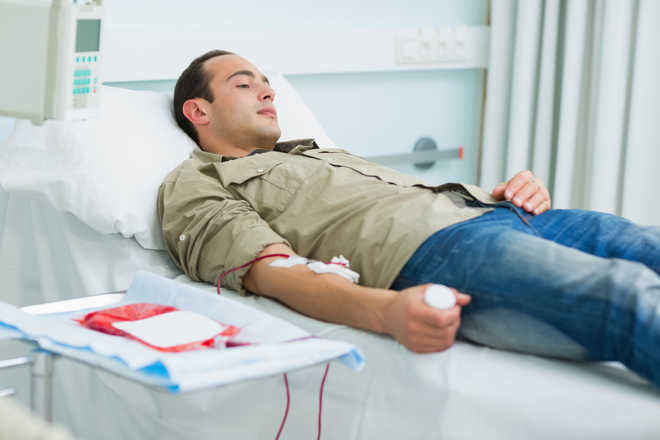
Dr J.B.Sharma
Thalassaemia (Mediterranean anaemia) is a genetic disorder of the blood in which the body is not able to make enough haemoglobin (or makes abnormal form of haemoglobin) causing excessive destruction of the red blood cells leading to severe anaemia.
Haemoglobin is the protein part of red blood cells that carries oxygen to all parts of the body. In thalassaemia cases, where insufficient haemoglobin is present in the blood, oxygen does not reach all parts properly. It causes starvation of oxygen in various organs and thereby increasing their inability to function properly.
Thalassaemia is inherited that means at least one parent is a carrier of the disease; it’s either genetic mutation or deletion of main gene fragments. If only one parent is a carrier, patient develops thalassaemia minor, wherein there are no symptoms or may develop minor symptoms like minor anaemia. In cases where both parents are carriers of the trait, the patient develops serious form the diseas called thalassaemia major (almost 25 per cent of the cases).
Thalassaemia is a complex group of diseases commonly prevalent in areas where P. falciparum malaria is common, including Asia, Africa, Middle & South East, China and Mediterranean countries like Greece and Italy.
In normal population, 95 per cent people have haemoglobin A which has four protein chains; two alpha and two beta globins (A2B2). At least 2-3 per cent population has haemoglobin A2 which has two alpha and two delta globins (A2D2). Less than two pc of the population has haemoglobin F (foetal haemoglobin) which has two alpha and two gamma globins (A2Y2). Haemoglobin F is produce by the foetus in the uterus of the mother and has high affinity for oxygen. After birth, adult haemoglobin rapidly increases and foetal haemoglobin productions drops.
In thalassaemia patients, mutation or deletion of genes that control globin production occurs causing decreased production of globin chains and abnormal haemoglobin ratio. This leads to decreased synthesis of haemoglobin and thereby thalassaemia expression. Various thalassaemias resemble another genetic disorder of the blood affecting haemoglobin, called sickle-cell anaemia.
Genetic testing and counselling are strongly recommended for the parents carrying thalassaemia trait before planning the baby. A large number of cases are being reported in Nepal, Pakistan and Bangladesh due to lack of this genetic testing.
Types of thalassaemia
Haemoglobin is made up of two types of proteins, Alpha globin and Beta globin. In thalassaemia, a defect occurs in a gene that controls production of one of these proteins. The main forms of thalassaemia are
Alpha-thalassaemia: Alpha-thalassaemia major is a serious disease in which no alpha globins are formed and thereby anaemia begins even before the birth of the baby. Pregnant mother carrying the baby is herself at serious risk of pregnancy and delivery complications. The baby is either stillborn or die shortly after birth. This form is generally incompatible with life.
Beta-thalassaemia: Thalassaemia major (Cooley’s Anaemia): The symptoms appear before second birthday of the child. It causes severe life-threatening anaemia. Other symptoms include paleness, poor appetite, frequent infections, enlargement of organs and jaundice. This is a serious form that requires regular blood transfusions.
Thalassaemia intermedia is a less severe form in which blood transfusions are not required.
Delta-thalassaemia: Just like beta-thalassaemia, in this mutations affect ability of the gene to produce delta chains.
Combined haemoglobinopathies: Thalassaemia can exist in combination with other haemoglobinopathies.
- Haemoglobin E/ thalassaemia is clinically similar to Beta-thalassaemia major or thalassaemia intermedia. It is common in Thailand, parts of India and Cambodia.
- Haemoglobin S/ thalassaemia is clinically similar to sickle-cell disease with feature of spleen enlargement too. It is common in African and Mediterranean countries.
- Haemoglobin C / thalassaemia causes moderately severe anaemia with spleen enlargement and is common in African and Mediterranean countries.
- Haemoglobin D/ thalassaemia is common in northwest parts of India and Pakistan.
Symptoms
Thalassaemia is detected during the screening of the newborn. If undiagnosed, newborn screening symptoms may include jaundice pallor or paleness, fatigue, headache, dizziness, fast heart beat, cramping of legs, poor growth, shortness of breath, bone changes, and/or pulmonary hypertension.
Iron overload can happen in patients due to disease itself or due to frequent blood transfusions. This can damage heart, liver, endocrine system (producing hormones). Almost all beta- thalassaemia patients get fatal iron levels.
Infection is also common in all patients, especially in case of spleen removal. Spleen aids in fighting infection and filters old unwanted cells. Increased destruction of red blood cells in thalassaemia causes spleen to enlarge and makes anaemia worse. This reduces the life of transfused cells. Severe enlargement demands spleen removal.
Bone deformities occur due to expansion of bones causing abnormal bone structures specially in skull and face. This expansion also causes thin and brittle bones increasing the risk of breaking of bones too.
Anaemia causes slowing of child’s growth and puberty delay also.
In case of untreated thalassaemia, patient may develop complications, including liver and heart enlargement, severe anaemia, congestive heart failure or abnormal heart rhythms, tumour masses (in non-transfused thalassaemia patients), and/or premature death.
Management
Thalassaemia is a treatable disorder, manageable with blood transfusions and chelation therapy (for iron overload). The type of treatment depends upon severity of the disease.
- People with mild thalassaemia do not require any management or follow-up.
- People with beta- thalassaemia trait should not be wrongly labelled as iron deficiency anaemia. High use of iron-supplements should be avoided.
- Patients with thalassaemia major require proper medical intervention. Learning how to stay healthy is most important. Blood transfusion regime is the first-line effective protocol in prolonging life of the patient.
- Sometimes, ‘alloimmunisation’ may occur which is the immune reaction of the body against the transfused blood cells. In such cases, blood has to be checked and compared first to patient’s own blood. These patients can get transfusions, but might have to wait long to get compatible blood.
- Bone marrow transplant offers possibility of cure in young patients with 85 per cent success rate; but there is 3 per cent mortality rate too. Donor compatibility is the major issue. In patients with incompatibility with donor, bone marrow transplantation from haploidentical mother may be used.
Regular transfusions make it important for the patient to get vaccinated against other blood borne diseases such as hepatitis as these viruses spread through blood. Routine paediatric immunisations must be done effectively. Nutritious meals, exercising, and keeping positive relationships are other tools.
— The writer is senior consultant, oncology,
Action Cancer Hospital, New Delhi



























